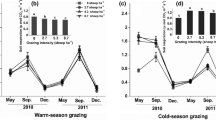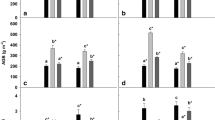Abstract
Different management practices may change the rate of soil respiration, thus affecting the carbon balance of grasslands. Therefore, we investigated the effect of grazing and mowing on soil respiration along with its driving variables (soil water content, soil temperature, above and below ground biomass, vegetation indices and soil carbon) in adjacent treatments (grazed and mowed) at a semi-arid grassland in Hungary (2011–2013). The average soil respiration over three years was higher in the mown (6.03 ± 4.07 µmol CO2 m−2 s−1) than in the grazed treatment (5.29 ± 3.50 µmol CO2 m−2 s−1). While soil water content and soil temperature did not differ between treatments, mowing resulted in 20 % higher soil respiration than grazing, possibly due to 17 % higher average above ground biomass in the mowed than in the grazed treatment. Inclusions of vegetation index VIGreen in the soil respiration model in addition to abiotic drivers improved the explained Rs variance by 16 % in the mowed and by 5 % in the grazed site, respectively. VIGreen alone proved to be a simple and fast indicator of soil respiration (r2 = 0.31 at grazed, r2 = 0.44 at mowed site). We conclude that soil respiration is responsive to the combined effect soil water content, soil temperature, biomass and soil carbon content as affected by the management (grazing vs. mowing) practice.




Similar content being viewed by others
References
Atkin OK, Edwards EJ, Loveys BR (2000) Response of root respiration to changes in temperature and its relevance to global warming. New Phytol 147:141–154
Bahn M, Rodeghiero M, Anderson-Dunn M et al (2008) Soil respiration in European grasslands in relation to climate and assimilate supply. Ecosystems 11:1352–1367. doi:10.1007/s10021-008-9198-0
Bahn M, Schmitt M, Siegwolf R et al (2009) Does photosynthesis affect grassland soil-respired CO2 and its carbon isotope composition on a diurnal timescale? New Phytol 182:451–460. doi:10.1111/j.1469-8137.2008.02755.x
Balogh J, Pintér K, Fóti S et al (2011) Dependence of soil respiration on soil moisture, clay content, soil organic matter, and CO2 uptake in dry grasslands. Soil Biol Biochem 43:1006–1013. doi:10.1016/j.soilbio.2011.01.017
Barcsák Z, Baskay-Tóth B, and Prieger K (1978) Gyeptermesztés és hasznosítás [Grass production and utilization] Budapest, Mezőazdasági Kiadó. 339 pp
Bond-Lamberty B, Thomson A (2010) Temperature-associated increases in the global soil respiration record. Nature 464:579–582
Bremer DJ, Ham JM, Owensby CE, Knapp AK (1998) Responses of soil respiration to clipping and grazing in a tallgrass prairie. J Environ Qual 27:1539–1548
Burri S, Sturm P, Prechsl UE et al (2014) The impact of extreme summer drought on the short-term carbon coupling of photosynthesis to soil CO2 efflux in a temperate grassland. Biogeosciences 11:961–975. doi:10.5194/bg-11-961-2014
Campbell GS (1986) Extinction coefficients for radiation in plant canopies calculated using an ellipsoidal inclination angle distribution. Agric For Meteorol 36:317–321. doi:10.1016/0168-1923(86)90010-9
Campbell GS, Norman JM (1989) The description and measurement of plant canopy structure. In: Russell G, Marshall B, Jarvis PG (eds) Plant canopies: their growth, form, and function. Society for Experimental Biology 31. Cambridge University Press, Cambridge, pp 1–19
Chen Q, Wang Q, Han X et al (2010) Temporal and spatial variability and controls of soil respiration in a temperate steppe in northern China. Glob Biogeochem Cycles 24:1–11. doi:10.1029/2009GB003538
Conant RT (2010) Challenges and opportunities for carbon sequestration in grassland systems: a technical report on grassland management and climate change mitigation. Integr Crop Manag 9:1–57
Craine J, Wedin D, Chapin FS III (1999) Predominance of ecophysiological controls on soil CO2 flux in a Minnesota grassland. Plant Soil 207:77–86. doi:10.1023/A:1004417419288
Curiel Yuste J, Janssens IA, Carrara A, Ceulemans R (2004) Annual Q10 of soil respiration reflects plant phenological patterns as well as temperature sensitivity. Glob Change Biol 10:161–169. doi:10.1111/j.1529-8817.2003.00727.x
Davidson E, Janssens I (2006) Temperature sensitivity of soil carbon decomposition and feedbacks to climate change. Nature 440:165–173. doi:10.1038/nature04514
De Beurs KM, Henebry GM (2005) A statistical framework for the analysis of long image time series. Int J Remote Sens 26:1551–1573. doi:10.1080/01431160512331326657
Fóti S, Balogh J, Nagy Z et al (2014) Soil moisture induced changes on fine-scale spatial pattern of soil respiration in a semi-arid sandy grassland. Geoderma 213:245–254. doi:10.1016/j.geoderma.2013.08.009
Frank AB, Liebig MA, Tanaka DL (2006) Management effects on soil CO2 efflux in northern semiarid grassland and cropland. Soil Tillage Res 89:78–85. doi:10.1016/j.still.2005.06.009
Geng Y, Wang Y, Yang K et al (2012) Soil respiration in Tibetan alpine grasslands: belowground biomass and soil moisture, but not soil temperature, best explain the large-scale patterns. PLoS ONE 7:e34968. doi:10.1371/journal.pone.0034968
Gitelson A, Kaufman YJ, Stark R, Rundquist D (2002) Novel algorithms for remote estimation of vegetation fraction. Remote Sens Environ 80:76–87
Gong J-R, Wang Y, Liu M et al (2014) Effects of land use on soil respiration in the temperate steppe of Inner Mongolia, China. Soil Tillage Res 144:20–31. doi:10.1016/j.still.2014.06.002
Guanter L, Zhang Y, Jung M et al (2014) Global and time-resolved monitoring of crop photosynthesis with chlorophyll fluorescence. Proc Natl Acad Sci USA 111:E1327–E1333. doi:10.1073/pnas.1320008111
Högberg P, Read DJ (2006) Towards a more plant physiological perspective on soil ecology. Trends Ecol Evol 21:548–554. doi:10.1016/j.tree.2006.06.004
Hou X, Wang Z, Michael SP et al (2014) The response of grassland productivity, soil carbon content and soil respiration rates to different grazing regimes in a desert steppe in northern China. Rangel J 36:573–582
Huang N, Niu Z (2012) Estimating soil respiration using spectral vegetation indices and abiotic factors in irrigated and rainfed agroecosystems. Plant Soil. doi:10.1007/s11104-012-1488-9
Hungarian Standard (1987) Physical, biological and chemical analysis of peat and peat mixes. Determination of organic matter and organic carbon content, MSZ-08-0012-6:1987. Budapest, 4 p
Hunt R (1990) Basic growth analysis. Unwin Hayman Ltd, London
IPCC (2006) Guidelines for national greenhouse gas inventories. Agriculture, forestry, and other land use, vol 4. Emissions from livestock and manure management, chap 10
Jia X, Wei X (2012) Agricultural and forest meteorology responses of soil respiration to N addition, burning and clipping in temperate semiarid grassland in northern China. Agric For Meteorol 166–167:32–40. doi:10.1016/j.agrformet.2012.05.022
Koncz P, Besnyői V, Csathó AI, Nagy J, Szerdahelyi T, Zs Tóth, Pintér K, Balogh J, Nagy ZBS (2014) Effect of grazing and mowing on the microcoenological composition of semi-arid grassland in Hungary. Appl Ecol Environmnetal Res 12:563–575
Lal R (2008) Soil carbon stocks under present and future climate with specific reference to European ecoregions. Nutr Cycl Agroecosyst 81:113–127. doi:10.1007/s10705-007-9147-x
Lloyd J, Taylor JA (1994) On the temperature dependence of soil respiration. Funct Ecol 8:315–323. doi:10.2307/2389824
Lou Y, Zhou X (2006) Soil respiration and the environment. Elsevier, Amsterdam
Luo Y (2007) Terrestrial carbon-cycle feedback to climate warming. Annu Rev Ecol Evol Syst 38:683–712. doi:10.1146/annurev.ecolsys.38.091206.095808
Molnár Z, Bartha S, Seregélyes T et al (2007) A grid-based, satellite-image supported, multi-attributed vegetation mapping method (MÉTA). Folia Geobot 42:225–247
Moyano FE, Manzoni S, Chenu C (2013) Responses of soil heterotrophic respiration to moisture availability: an exploration of processes and models. Soil Biol Biochem 59:72–85. doi:10.1016/j.soilbio.2013.01.002
Nagy Z, Pintér K, Czóbel S et al (2007) The carbon budget of semi-arid grassland in a wet and a dry year in Hungary. Agric Ecosyst Environ 121:21–29. doi:10.1016/j.agee.2006.12.003
Nagy Z, Pintér K, Pavelka M et al (2011) Carbon balance of surfaces vs. ecosystems: advantages of measuring eddy covariance and soil respiration simultaneously in dry grassland ecosystems. Biogeosci Discuss 8:941–973. doi:10.5194/bg-8-2523-2011
Necpálová M, Li D, Lanigan G et al (2014) Changes in soil organic carbon in a clay loam soil following ploughing and reseeding of permanent grassland under temperate moist climatic conditions. Grass Forage Sci 69:611–624. doi:10.1111/gfs.12080
Sakamoto T, Gitelson AA, Nguy-Robertson AL et al (2012) An alternative method using digital cameras for continuous monitoring of crop status. Agric For Meteorol 154–155:113–126. doi:10.1016/j.agrformet.2011.10.014
Shahzad T, Chenu C, Repinçay C et al (2012) Plant clipping decelerates the mineralization of recalcitrant soil organic matter under multiple grassland species. Soil Biol Biochem 51:73–80. doi:10.1016/j.soilbio.2012.04.014
Shrestha BM, Sitaula BK, Singh BR, Bajracharya RM (2004) Fluxes of CO2 and CH4 in soil profiles of a mountainous watershed of Nepal as influenced by land use, temperature, moisture and substrate. Nutr Cycl Agroecosyst 68:155–164
Silleos NG, Alexandridis TK (1996) Vegetation indices: advances made in biomass estimation and vegetation monitoring in the last 30 years. Geocarto Int 21:21–28
Singh JS, Lauenroth WK, Milchunas DG (1983) Geography of grassland ecosystems. Prog Phys Geogr 7:46–80. doi:10.1177/030913338300700102
Smith P, Cai Z, Martino D et al (2008) Greenhouse gas mitigation in agriculture. Philos Trans R Soc Lond B Biol Sci 363:789–813. doi:10.1098/rstb.2007.2184
Soussana J, Loiseau P, Vuichard N, et al (2004) Carbon cycling and sequestration opportunities in temperate grasslands. Soil Use Manag. doi: 10.1079/SUM2003234
Soussana JF, Allard V, Pilegaard K et al (2007) Full accounting of the greenhouse gas (CO2, N2O, CH4) budget of nine European grassland sites. Agric Ecosyst Environ 121:121–134. doi:10.1016/j.agee.2006.12.022
Stark S, Tuomi J, Strömmer R, Helle T (2003) Non-parallel changes in soil microbial carbon and nitrogen dynamics due to reindeer grazing in northern boreal forests. Ecography (Cop) 26:51–59. doi:10.1034/j.1600-0587.2003.03336.x
Stehfest E, Bouwman L, Vuuren DP et al (2009) Climate benefits of changing diet. Clim Change 95:83–102. doi:10.1007/s10584-008-9534-6
Thorne M, Frank D (2008) The effects of clipping and soil moisture on leaf and root morphology and root respiration in two temperate and two tropical grasses. Plant Ecol 200:205–215. doi:10.1007/s11258-008-9445-7
Vinczeffy I (1993) Legelő és gyepgazdálkodás [Pasture and grassland management]. Mezőgazda Kiadó, Budapest
Wan S, Luo Y (2003) Substrate regulation of soil respiration in a tallgrass prairie: results of a clipping and shading experiment. Global Biogeochem CY 17:1–12. doi:10.1029/2002GB001971
Wang WJ, Zu YG, Wang HM et al (2005) Effect of collar insertion on soil respiration in a larch forest measured with a LI-6400 soil CO2 flux system. J For Res 10:57–60. doi:10.1007/s10310-004-0102-2
Wang M, Liu X, Zhang J et al (2015) Soil respiration associated with plant succession at the meadow steppes in Songnen Plain, Northeast China. J Plant Ecol 8:51–60. doi:10.1093/jpe/rtu006
Zhang G, Kang Y, Han G et al (2011) Grassland degradation reduces the carbon sequestration capacity of the vegetation and enhances the soil carbon and nitrogen loss. Acta Agric Scand Sect B-Soil Plant Sci 61:356–364. doi:10.1080/09064710.2010.495079
Acknowledgments
The research leading to these results has been conducted as part of the “AnimalChange” Project which received funding from the European Community’s Seventh Framework Programme (FP7/2007–2013) under the Grant Agreement No. 266018. János Balogh acknowledges the support of the Hungarian Scientific Research Fund (OTKA PD 100575) Project and the János Bolyai Research Scholarship of the Hungarian Academy of Sciences. Szilvia Fóti acknowledges the support of the János Bolyai Research Scholarship of the Hungarian Academy of Sciences. We would like to express our thank for the help of the Kiskunság National Park. We are grateful for the intensive soil and biomass sample analysis to Helga Nagy Tiborné Déri, Zsófi Lucsik, Bernadett Surányi, Erika Guba, Berta Roberta, Sipőcz Vivien, Ildikó Maraffai and Tibor Kocsis.
Author information
Authors and Affiliations
Corresponding author
Rights and permissions
About this article
Cite this article
Koncz, P., Balogh, J., Papp, M. et al. Higher soil respiration under mowing than under grazing explained by biomass differences. Nutr Cycl Agroecosyst 103, 201–215 (2015). https://doi.org/10.1007/s10705-015-9732-3
Received:
Accepted:
Published:
Issue Date:
DOI: https://doi.org/10.1007/s10705-015-9732-3




